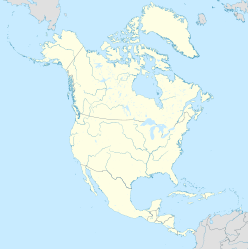Whitecourt crater facts for kids
| Impact crater/structure | |
|---|---|
| Confidence | Confirmed |
| Diameter | 36 m (118 ft) |
| Depth | 6 m (20 ft) |
| Age | 1,080-1,130 Y |
| Location | |
| Coordinates | 53°59′55″N 115°35′45″W / 53.9987°N 115.5957°W |
| Country | Canada |
| Province | Alberta |
The Whitecourt crater is a special place in central Alberta, Canada. It's a hole in the ground made by a meteorite hitting Earth! This crater is quite unique because it's very well-preserved. Even though it's not super old or huge, it's a great spot for scientists to learn about space rocks and their impacts.
Contents
Discovering the Whitecourt Crater
The Whitecourt crater is about 10 kilometers (6 miles) southeast of the town of Whitecourt. It is located within Woodlands County. The crater is roughly 36 meters (118 feet) wide. It is also about 6 meters (20 feet) deep.
Scientists believe the crater was formed between 1,080 and 1,130 years ago. They found pieces of the meteorite above a layer of ash from an old forest fire. This fire happened around 1,100 years ago. This helps them figure out when the impact happened.
How the Crater Was Found
A local resident named Sonny Stevens found the crater on July 3, 2007. He was hunting in the area. Later, he used a metal detector near the crater's edge. That's when he found the first pieces of the meteorite.
Dr. Chris Herd, a professor at the University of Alberta, confirmed the discovery. He studied the rock pieces. This proved that the crater was indeed made by a meteorite.
Protecting the Site
The area around the crater is now a protected zone. This zone is 200 meters by 200 meters (about 656 feet by 656 feet). It's protected to keep the site safe for study. Collecting anything from inside this zone is not allowed.
However, many meteorite pieces have been found outside this protected area. These pieces were found on Crown land. This is land owned by the government.
What Was Found There
By 2012, more than 3,000 pieces of the meteorite had been found. Most of these pieces are small, weighing between a few grams and 500 grams. They have sharp edges. They also look like they were bent or squashed from the impact.
Scientists call these pieces "shrapnel." This means they broke apart violently. Interestingly, these pieces do not show signs of melting from the impact.
Types of Meteorites Found
About half a dozen larger, whole meteorites were also found. The biggest one weighs 31 kilograms (68 pounds). These meteorites are made of iron. They belong to a group called IIIAB meteorites.
Most of the meteorite pieces were thrown eastward from the crater. This tells scientists about the direction the meteorite came from. It also helps them understand how the impact happened.


